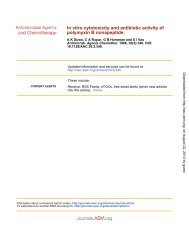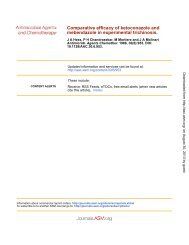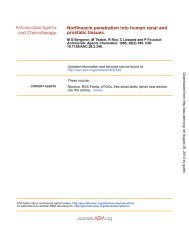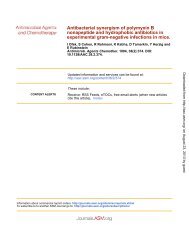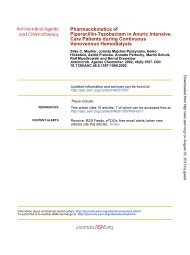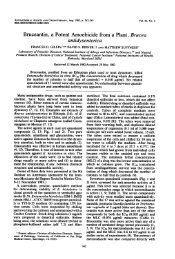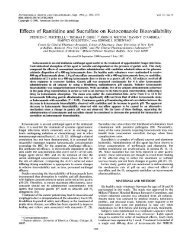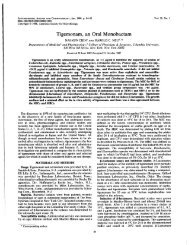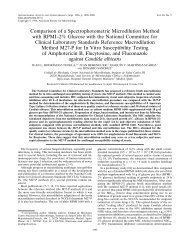In Vitro Susceptibility of Coxiella burnetii to Trovaffoxacin in ...
In Vitro Susceptibility of Coxiella burnetii to Trovaffoxacin in ...
In Vitro Susceptibility of Coxiella burnetii to Trovaffoxacin in ...
You also want an ePaper? Increase the reach of your titles
YUMPU automatically turns print PDFs into web optimized ePapers that Google loves.
ANTIMICROBIAL AGENTS AND CHEMOTHERAPY, Oct. 1998, p. 2747–2748 Vol. 42, No. 10<br />
0066-4804/98/$04.000<br />
Copyright © 1998, American Society for Microbiology. All Rights Reserved.<br />
<strong>In</strong> <strong>Vitro</strong> <strong>Susceptibility</strong> <strong>of</strong> <strong>Coxiella</strong> <strong>burnetii</strong> <strong>to</strong> Trovafloxac<strong>in</strong> <strong>in</strong><br />
Comparison with Susceptibilities <strong>to</strong> Pefloxac<strong>in</strong>,<br />
Cipr<strong>of</strong>loxac<strong>in</strong>, Ofloxac<strong>in</strong>, Doxycycl<strong>in</strong>e,<br />
and Clarithromyc<strong>in</strong><br />
ACHILLEAS GIKAS,* IOANNA SPYRIDAKI, ANNA PSAROULAKI,<br />
DIAMANTIS KOFTERITHIS, AND YANNIS TSELENTIS<br />
Cl<strong>in</strong>ical Bacteriology, Parasi<strong>to</strong>logy, Zoonoses, and Geographical Medic<strong>in</strong>e, University Hospital<br />
<strong>of</strong> Heraklion, 1352/71110 Crete, Greece<br />
Received 24 April 1998/Returned for modification 28 May 1998/Accepted 16 July 1998<br />
The antibiotic susceptibilities <strong>of</strong> eight Greek isolates <strong>of</strong> <strong>Coxiella</strong> <strong>burnetii</strong> <strong>to</strong> trovafloxac<strong>in</strong> were determ<strong>in</strong>ed by<br />
the shell vial assay. MICs <strong>of</strong> trovafloxac<strong>in</strong> and <strong>of</strong>loxac<strong>in</strong> ranged from 1 <strong>to</strong> 2 g/ml, those <strong>of</strong> pefloxac<strong>in</strong> ranged<br />
from1<strong>to</strong>4g/ml, those <strong>of</strong> cipr<strong>of</strong>loxac<strong>in</strong> ranged from 4 <strong>to</strong> 8 g/ml, those <strong>of</strong> doxycycl<strong>in</strong>e ranged from 1 <strong>to</strong> 2 g/<br />
ml, and those <strong>of</strong> clarithromyc<strong>in</strong> ranged from 2 <strong>to</strong> 4 g/ml. Trovafloxac<strong>in</strong> exhibited no activity aga<strong>in</strong>st C. <strong>burnetii</strong><br />
at 4 g/ml.<br />
<strong>Coxiella</strong> <strong>burnetii</strong> is the etiologic agent <strong>of</strong> Q fever. Two major<br />
forms <strong>of</strong> the disease are known: acute and chronic (1). The<br />
acute form <strong>of</strong> the disease is usually a self-limit<strong>in</strong>g acute febrile<br />
illness, dur<strong>in</strong>g which pneumonia or hepatitis may occur. However,<br />
the chronic form is a severe disease <strong>in</strong> which endocarditis<br />
predom<strong>in</strong>ates (8). Whereas acute C. <strong>burnetii</strong> <strong>in</strong>fections respond<br />
<strong>to</strong> antibiotic therapy, chronic <strong>in</strong>fections are hard <strong>to</strong> cure<br />
(3, 12).<br />
The efficacies <strong>of</strong> qu<strong>in</strong>olones aga<strong>in</strong>st these types <strong>of</strong> <strong>in</strong>fection<br />
have yet <strong>to</strong> be established. <strong>In</strong> this paper we studied the activity<br />
<strong>of</strong> a new qu<strong>in</strong>olone, trovafloxac<strong>in</strong>, aga<strong>in</strong>st C. <strong>burnetii</strong>, us<strong>in</strong>g<br />
Vero cell tissue cultures. We also compared its bacteriostatic<br />
effect with those <strong>of</strong> five other antibiotic compounds on eight<br />
Greek isolates derived from human samples.<br />
S<strong>to</strong>ck solutions <strong>of</strong> trovafloxac<strong>in</strong> (20 mg/ml; k<strong>in</strong>dly provided<br />
by Pfizer <strong>In</strong>c., New York, N.Y.), pefloxac<strong>in</strong> (400 mg/5 ml;<br />
Rhone Poulenc S.A., Paris, France), cipr<strong>of</strong>loxac<strong>in</strong> (100 mg/50<br />
ml; Bayer AG, Leverkuzen, Germany), and <strong>of</strong>loxac<strong>in</strong> (220 mg/<br />
100 ml; Hoechst AG, Frankfurt am Ma<strong>in</strong>, Germany) were prepared.<br />
For doxycycl<strong>in</strong>e (Pfizer <strong>In</strong>c.) and clarithromyc<strong>in</strong> (Abbott<br />
Labora<strong>to</strong>ries, Chicago, Ill.), s<strong>to</strong>ck solutions at 6 mg/ml<br />
were prepared by us<strong>in</strong>g methanol.<br />
All stra<strong>in</strong>s were grown <strong>in</strong> Vero cells as previously described<br />
(10). The bacteriostatic and bactericidal effects on C. <strong>burnetii</strong><br />
were tested by the shell vial assay. For this purpose an acute<strong>in</strong>fection<br />
model with the N<strong>in</strong>e-Mile stra<strong>in</strong> and a chronic-<strong>in</strong>fection<br />
model with the Q212 stra<strong>in</strong> were employed (1, 10). <strong>In</strong><br />
addition, the concentration <strong>of</strong> the <strong>in</strong>oculum that was previously<br />
determ<strong>in</strong>ed <strong>to</strong> <strong>in</strong>fect 30 <strong>to</strong> 50% <strong>of</strong> Vero cells was used <strong>to</strong> <strong>in</strong>fect<br />
the shell vials for the antibiotic challenge (10). Bacterial growth<br />
was evaluated after 6 days <strong>of</strong> <strong>in</strong>cubation by <strong>in</strong>direct immun<strong>of</strong>luorescence,<br />
and the results were scored as follows: R for<br />
resistance, with growth comparable <strong>to</strong> that <strong>of</strong> the control; I for<br />
<strong>in</strong>termediate susceptibility, with less than 10% <strong>in</strong>fected cells;<br />
and S for susceptibility, with the absence <strong>of</strong> <strong>in</strong>fected cells (10).<br />
* Correspond<strong>in</strong>g author. Mail<strong>in</strong>g address: Cl<strong>in</strong>ical Bacteriology,<br />
Parasi<strong>to</strong>logy, and Geographical Medic<strong>in</strong>e, University Hospital <strong>of</strong> Heraklion,<br />
1352/71110 Crete, Greece. Phone: 30-81-392360. Fax: 30-81-<br />
392847. E-mail: achille@edu.uch.gr.<br />
2747<br />
The bactericidal activity <strong>of</strong> trovafloxac<strong>in</strong> was assessed by the<br />
quantitative method described by Maur<strong>in</strong> and Raoult (6). Trovafloxac<strong>in</strong><br />
was added <strong>to</strong> the culture medium at 4 g/ml. Viable<br />
organisms were identified after 6 days <strong>in</strong> the culture, and bactericidal<br />
activity corresponded <strong>to</strong> a significant reduction <strong>in</strong> bacterial<br />
titer (at least 2 <strong>to</strong> 3 dilutions) after antibiotic exposure,<br />
compared with that <strong>in</strong> the primary <strong>in</strong>oculum dose (5, 6).<br />
Trovafloxac<strong>in</strong> showed bacteriostatic activity <strong>to</strong>ward C. <strong>burnetii</strong>.<br />
Complete bacterial growth <strong>in</strong>hibition was obta<strong>in</strong>ed with<br />
1 g per ml <strong>in</strong> tests with the N<strong>in</strong>e-Mile isolate and with seven<br />
<strong>of</strong> eight Greek isolates. <strong>In</strong>hibition was also obta<strong>in</strong>ed with 2<br />
g/ml <strong>in</strong> tests with the Q212 stra<strong>in</strong> and the last Greek isolate<br />
(Table 1). These concentrations are below those achieved <strong>in</strong><br />
human serum with the recommended s<strong>in</strong>gle oral dose <strong>of</strong> 200<br />
mg <strong>of</strong> trovafloxac<strong>in</strong> (2.2 g/ml).<br />
Vero cells were persistently <strong>in</strong>fected with the N<strong>in</strong>e-Mile and<br />
Q212 C. <strong>burnetii</strong> stra<strong>in</strong>s for 5 months before be<strong>in</strong>g tested. Only<br />
these two stra<strong>in</strong>s were tested <strong>in</strong> bactericidal experiments with<br />
trovafloxac<strong>in</strong>. No bactericidal activity was demonstrated with 4<br />
g <strong>of</strong> trovafloxac<strong>in</strong> per ml when these cells were exam<strong>in</strong>ed.<br />
All MICs recorded were compared with each other and with<br />
the peak concentration <strong>of</strong> each antibiotic <strong>in</strong> serum. The MICs<br />
<strong>of</strong> all the antibiotics tested are summarized <strong>in</strong> Table 2.<br />
At the concentrations tested, trovafloxac<strong>in</strong>, <strong>of</strong>loxac<strong>in</strong>, and<br />
doxycycl<strong>in</strong>e showed improved bacteriostatic activities <strong>in</strong> vitro<br />
TABLE 1. Susceptibilities <strong>of</strong> C. <strong>burnetii</strong> stra<strong>in</strong>s <strong>to</strong> trovafloxac<strong>in</strong><br />
determ<strong>in</strong>ed by the shell vial technique<br />
Trovafloxac<strong>in</strong><br />
concn<br />
(g/ml)<br />
<strong>Susceptibility</strong> a <strong>of</strong> <strong>in</strong>dicated stra<strong>in</strong><br />
N<strong>in</strong>e Mile Q212 CP1 CP2 CP3 CP4 CP5 CP6 CP7 CP8<br />
0.25 R R R R R R R R R R<br />
0.5 I R R I I I I I I I<br />
1.0 S I I S S S S S S S<br />
2.0 S S S S S S S S S S<br />
4.0 S S S S S S S S S S<br />
8.0 S S S S S S S S S S<br />
16.0 S S S S S S S S S S<br />
a See the text.<br />
Downloaded from http://aac.asm.org/ on August 31, 2013 by guest




